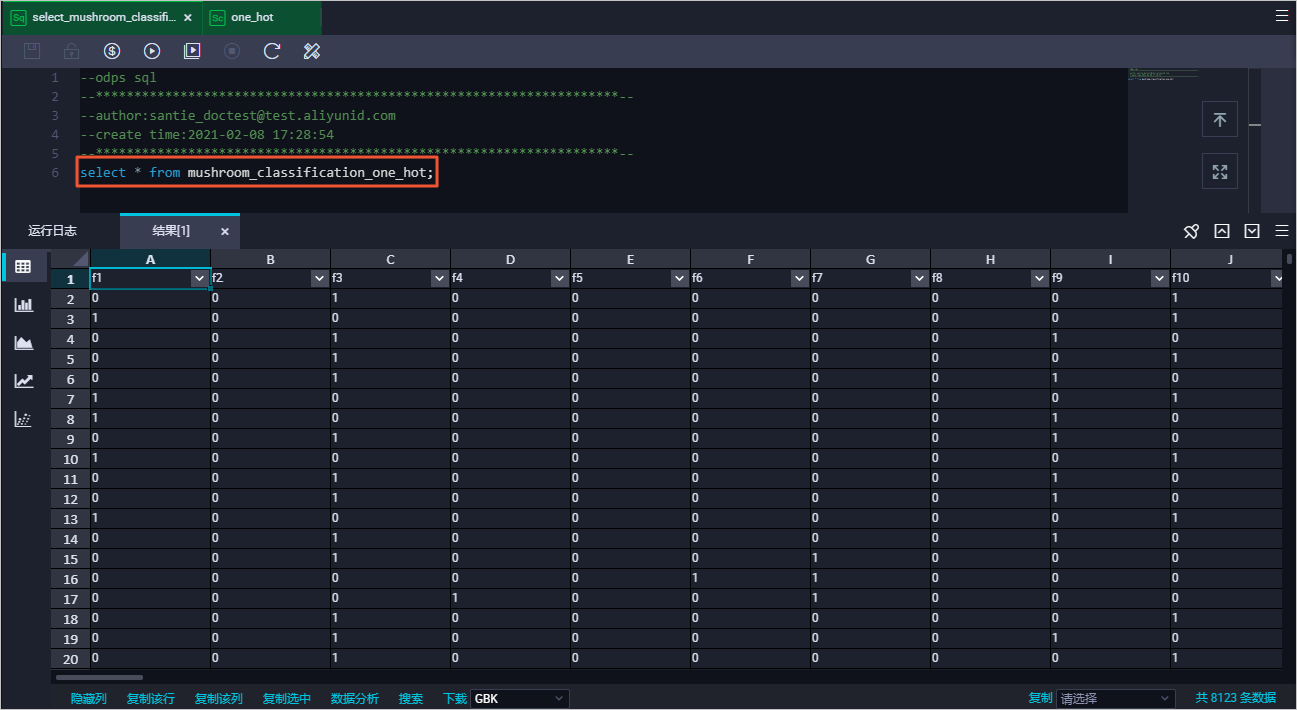本文以開來源資料集(Mushroom Data Set)為例,為您介紹如何快速使用MaxCompute SQLML及機器學習的羅吉斯迴歸二分類模型預測蘑菇是否有毒。
前提條件
登入阿里雲帳號,並完成實名認證。更多資訊,請參見準備阿里雲帳號。
如果您需要使用RAM使用者身份進行操作,請確認帳號可用並已授權,詳情請參見準備RAM使用者。
操作步驟
可選:開通MaxCompute隨用隨付服務、DataWorks(基礎版)服務及Platform for AI(PAI(Designer、DLC、EAS)隨用隨付開通)服務,三種服務的開通地區保持一致。
進入阿里雲MaxCompute產品首頁,單擊立即購買。
更多MaxCompute服務開通訊息,請參見開通MaxCompute和DataWorks。
說明如果您未開通過MaxCompute服務,通過該方式開通MaxCompute服務時,預設會為您開通DataWorks基礎版服務(免費)和MaxCompute隨用隨付服務。
如果您已開通MaxCompute隨用隨付服務,請忽略本步驟。
進入DataWorks購買頁面,購買基礎版服務。
更多DataWorks服務開通訊息,請參見開通DataWorks。
 說明
說明如果您已開通DataWorks基礎版服務,請忽略本步驟。
進入Platform for AI購買頁面,開通PAI並建立預設工作空間。
更多Platform for AI服務開通訊息,請參見開通PAI並建立預設工作空間。
 說明
說明如果您已開通PAI並建立了工作空間,請忽略本步驟。
下載Mushroom Data Set資料集檔案agaricus-lepiota.data,並儲存為TXT、CSV或LOG檔案類型。例如agaricus-lepiota.data.txt。
登入DataWorks控制台,建立或配置DataWorks工作空間。
如果已有DataWorks工作空間,請為目標工作空間配置MaxCompute計算引擎,並開啟調度PAI演算法任務開關。
單擊左側導覽列的工作空間,進入工作空間列表頁面。
在工作空間列表頁面,單擊目標工作空間操作列的管理。
在左側導覽列選擇工作空間,在基礎配置頁簽的基本屬性地區開啟調度PAI演算法任務。
單擊左側導覽列的,進入資料來源頁面,建立MaxCompute資料來源。資料來源建立方法請參見建立MaxCompute資料來源。
如果沒有DataWorks工作空間,請建立DataWorks工作空間。配置計算引擎服務為MaxCompute,並開啟調度PAI演算法任務開關。更多建立DataWorks工作空間資訊,請參見建立工作空間。
通過DataWorks建立表mushroom_classification並匯入準備好的資料集資訊。
單擊目標DataWorks工作空間操作列的快速進入 > 資料開發,建立表mushroom_classification。
更多建立表操作資訊,請參見建立並使用MaxCompute表。
建立表的DDL語句樣本如下:
create table mushroom_classification ( label string comment 'poisonous=p,edible=e', cap_shape string comment 'bell=b,conical=c,convex=x,flat=f,knobbed=k,sunken=s', cap_surface string comment 'fibrous=f,grooves=g,scaly=y,smooth=s', cap_color string comment 'brown=n,buff=b,cinnamon=c,gray=g,green=r,pink=p,purple=u,red=e,white=w,yellow=y', bruises string comment 'bruises=t,no=f', odor string comment 'almond=a,anise=l,creosote=c,fishy=y,foul=f,musty=m,none=n,pungent=p,spicy=s', gill_attachment string comment 'attached=a,descending=d,free=f,notched=n', gill_spacing string comment 'close=c,crowded=w,distant=d', gill_size string comment 'broad=b,narrow=n', gill_color string comment 'black=k,brown=n,buff=b,chocolate=h,gray=g,green=r,orange=o,pink=p,purple=u,red=e,white=w,yellow=y', stalk_shape string comment 'enlarging=e,tapering=t', stalk_root string comment 'bulbous=b,club=c,cup=u,equal=e,rhizomorphs=z,rooted=r,missing=?', stalk_surface_above_ring string comment 'fibrous=f,scaly=y,silky=k,smooth=s', stalk_surface_below_ring string comment 'fibrous=f,scaly=y,silky=k,smooth=s', stalk_color_above_ring string comment 'brown=n,buff=b,cinnamon=c,gray=g,orange=o,pink=p,red=e,white=w,yellow=y', stalk_color_below_ring string comment 'brown=n,buff=b,cinnamon=c,gray=g,orange=o,pink=p,red=e,white=w,yellow=y', veil_type string comment 'partial=p,universal=u', veil_color string comment 'brown=n,orange=o,white=w,yellow=y', ring_number string comment 'none=n,one=o,two=t', ring_type string comment 'cobwebby=c,evanescent=e,flaring=f,large=l,none=n,pendant=p,sheathing=s,zone=z', spore_print_color string comment 'black=k,brown=n,buff=b,chocolate=h,green=r,orange=o,purple=u,white=w,yellow=y', population string comment 'abundant=a,clustered=c,numerous=n,scattered=s,several=v,solitary=y', habitat string comment 'grasses=g,leaves=l,meadows=m,paths=p,urban=u,waste=w,woods=d' );將資料集檔案agaricus-lepiota.data.txt的資訊匯入表mushroom_classification中,欄位匹配方式選擇按位置匹配。
更多上傳資料操作資訊,請參見上傳本機資料。

使用DataWorks的臨時查詢功能,建立MaxCompute ODPS SQL節點,執行SQL命令驗證資料匯入結果。
更多臨時查詢操作資訊,請參見使用臨時查詢運行SQL語句(可選)。
命令樣本如下:
select * from mushroom_classification;返回結果如下:

對匯入表mushroom_classification中的資料通過one-hot編碼方式進行處理。
由於羅吉斯迴歸二分類模型要求欄位為數實值型別,此處通過one-hot編碼方式,將枚舉類型的值轉為數實值型別。例如cap_shape對應的值為
b、c、x、f、k、s6個值,one-hot編碼方式會將這6個枚舉值轉為6列,每一列對應一個枚舉值,當cap_shape的值與對應列的枚舉值相等時填1,否則填0。可選:建立商務程序。例如mc_test。
更多建立商務程序操作資訊,請參見建立周期商務程序。
說明如果您已有建立好的商務程序,可直接使用,請忽略本步驟。
建立MaxCompute ODPS Script節點,編寫代碼,對匯入的資料按照one-hot編碼方式進行處理並寫入新表mushroom_classification_one_hot中。
更多建立ODPS Script節點資訊,請參見開發ODPS Script任務。
命令樣本如下:
create temporary function one_hot as 'onehot.OneHotEncoding' using #CODE ('lang'='JAVA') package onehot; import com.aliyun.odps.udf.UDFException; import com.aliyun.odps.udf.UDTF; import com.aliyun.odps.udf.annotation.Resolve; import java.io.IOException; import java.util.ArrayList; import java.util.List; @Resolve({"string,string,string,string,string,string,string,string,string,string," + "string,string,string,string,string,string,string,string,string,string,string,string" + "->" + "bigint,bigint,bigint,bigint,bigint,bigint,bigint,bigint,bigint,bigint,"+ "bigint,bigint,bigint,bigint,bigint,bigint,bigint,bigint,bigint,bigint," + "bigint,bigint,bigint,bigint,bigint,bigint,bigint,bigint,bigint,bigint," + "bigint,bigint,bigint,bigint,bigint,bigint,bigint,bigint,bigint,bigint," + "bigint,bigint,bigint,bigint,bigint,bigint,bigint,bigint,bigint,bigint," + "bigint,bigint,bigint,bigint,bigint,bigint,bigint,bigint,bigint,bigint," + "bigint,bigint,bigint,bigint,bigint,bigint,bigint,bigint,bigint,bigint," + "bigint,bigint,bigint,bigint,bigint,bigint,bigint,bigint,bigint,bigint," + "bigint,bigint,bigint,bigint,bigint,bigint,bigint,bigint,bigint,bigint," + "bigint,bigint,bigint,bigint,bigint,bigint,bigint,bigint,bigint,bigint," + "bigint,bigint,bigint,bigint,bigint,bigint,bigint,bigint,bigint,bigint," + "bigint,bigint,bigint,bigint,bigint,bigint,bigint,bigint,bigint,bigint," + "bigint,bigint,bigint,bigint,bigint,bigint"}) public class OneHotEncoding extends UDTF { private static char[][] features = { { 'b','c','x','f','k','s'}, //cap-shape { 'f','g','y','s'}, //cap-surface { 'n','b','c','g','r','p','u','e','w','y'}, //cap-color { 't','f'}, //bruises { 'a','l','c','y','f','m','n','p','s'}, //odor { 'a','d','f','n'}, //gill-attachment { 'c','w','d'}, //gill-spacing { 'b','n'}, //gill-size { 'k','n','b','h','g','r','o','p','u','e','w','y'}, //gill-color { 'e','t'}, //stalk-shape { 'b','c','u','e','z','r','?'}, //stalk-root { 'f','y','k','s'}, //stalk-surface-above-ring { 'f','y','k','s'}, //stalk-surface-below-ring { 'n','b','c','g','o','p','e','w','y'}, //stalk-color-above-ring { 'n','b','c','g','o','p','e','w','y'}, //stalk-color-below-ring { 'p','u'}, //veil-type { 'n','o','w','y'}, //veil-color { 'n','o','t'}, //ring-number { 'c','e','f','l','n','p','s','z'}, //ring-type { 'k','n','b','h','r','o','u','w','y'}, //spore-print-color { 'a','c','n','s','v','y'}, //population { 'g','l','m','p','u','w','d'}, //habitat }; @Override public void process(Object[] objects) throws UDFException, IOException { List<Long> featuresEncoding = new ArrayList<>(126); for (int i = 0; i < objects.length; i++) { String value = (String)objects[i]; char[] feature = features[i]; for (char c : feature) { featuresEncoding.add(value.charAt(0) == c ? 1L : 0L); } } forward(featuresEncoding.toArray()); } } #END CODE; create table mushroom_classification_one_hot as select t.*, label from mushroom_classification lateral view one_hot(cap_shape,cap_surface,cap_color,bruises,odor,gill_attachment, gill_spacing, gill_size, gill_color, stalk_shape,stalk_root , stalk_surface_above_ring,stalk_surface_below_ring,stalk_color_above_ring, stalk_color_below_ring,veil_type,veil_color,ring_number,ring_type,spore_print_color, population,habitat) t AS f1,f2,f3,f4,f5,f6,f7,f8,f9,f10,f11,f12,f13,f14,f15,f16,f17,f18,f19,f20, f21,f22,f23,f24,f25,f26,f27,f28,f29,f30,f31,f32,f33,f34,f35,f36,f37,f38,f39,f40, f41,f42,f43,f44,f45,f46,f47,f48,f49,f50,f51,f52,f53,f54,f55,f56,f57,f58,f59,f60, f61,f62,f63,f64,f65,f66,f67,f68,f69,f70,f71,f72,f73,f74,f75,f76,f77,f78,f79,f80, f81,f82,f83,f84,f85,f86,f87,f88,f89,f90,f91,f92,f93,f94,f95,f96,f97,f98,f99,f100, f101,f102,f103,f104,f105,f106,f107,f108,f109,f110,f111,f112,f113,f114,f115,f116, f117,f118,f119,f120,f121,f122,f123,f124,f125,f126;使用DataWorks的臨時查詢功能,建立MaxCompute ODPS SQL節點,執行SQL命令驗證one-hot處理結果。
命令樣本如下:
select * from mushroom_classification_one_hot;返回結果如下:

使用DataWorks的臨時查詢功能,建立MaxCompute ODPS SQL節點,基於表mushroom_classification_one_hot中的資料建立訓練資料集和測試資料集。
命令樣本如下:
--訓練資料集。1/4的資料用於模型訓練。 create table mushroom_training as select * from mushroom_classification_one_hot where sample(4,1); --測試資料集。其餘3/4的資料用於預測和評估。 create table mushroom_predict as select * from mushroom_classification_one_hot except all select * from mushroom_training;
建立機器學習模型並做預測。
使用DataWorks的臨時查詢功能,建立MaxCompute ODPS SQL節點,基於訓練資料集建立羅吉斯迴歸二分類模型lr_test_model。
命令樣本如下:
create model lr_test_model with properties('model_type'='logisticregression_binary', 'goodValue'='p','maxIter'='1000') as select * from mushroom_training;說明properties中還可以指定更多參數,參數和Platform for AI平台保持一致,請參見線性支援向量機。SQL引擎會把
as後的查詢語句提取出來單獨運行,結果存放在一個暫存資料表中,您可以在作業的Logview的Summary資訊中查看。暫存資料表的生命週期為1天,逾時會自動回收。如果後續需要刪除模型,可以執行
drop offlinemodel lr_test_model命令。
使用DataWorks的臨時查詢功能,建立MaxCompute ODPS SQL節點,基於模型lr_test_model,通過內建函數
ml_predict對測試資料集中的資料進行預測。命令樣本如下:
create table mushroom_predict_result as select * from ml_predict( lr_test_model, (select * from mushroom_predict) );說明SQL引擎會把
ml_predict函數下的子查詢結果儲存到暫存資料表。暫存資料表的生命週期為1天,逾時會自動回收。ml_predict的結果可以直接放在SQL查詢from子句中,也可以通過insert或create table as語句存到另一個表中。更多ml_predict資訊,請參見支援的預測模型函數。
使用DataWorks的臨時查詢功能,建立MaxCompute ODPS SQL節點,執行SQL命令查看錶mushroom_predict_result中的預測結果。
命令樣本如下:
select * from mushroom_predict_result;返回結果如下:

通過內建函數
ml_evaluate評估模型的預測準確度。更多
ml_evaluate資訊,請參見支援的評估模型函數。